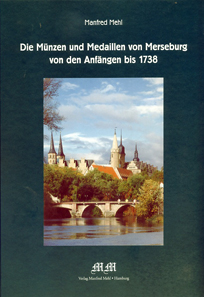by Ursula Kampmann
translated by Annika Backe
June 18, 2015 – Once again, Manfred Mehl presents a new, exemplary corpus that brings together everything a numismatist can access: the material, the archival records, and the hoard finds. This time, the subject-matter is Merseburg, the important cathedral city on the Saale River that became an imperial palace as early as the 10th century. In 980, the city was granted the minting privilege by Otto II for the first time. The first coins we can surely identify, however, date to the years between 1009 and 1018. Magnificent bracteates were manufactured in Merseburg before the production of coins was brought to a temporary halt around 1300. Yet Merseburg exerted his right to mint coins from time to time: in the 14th century when it produced bracteates, for example, or – being in good company with many others who remembered that they still possessed the minting privilege granted long ago – during the Kipper and Wipper Period.
Manfred Mehl, Die Münzen und Medaillen von Merseburg von den Anfängen bis 1738. Verlag Manfred Mehl, Hamburg, 2015. 250 pages with illustrations in color and black and white. 21.8 x 30.3 cm. Hardcover. ISBN: 978-3-933420-04-0. 50 euros.
Manfred Mehl is presenting the material with due attention to detail. He has written a type catalog that is the perfect tool to identify coins with. His book is much more though.
It starts with the history of research and goes on to tell the history of the Bishopric of Merseburg. Outclassing even the most comprehensive internet lexicon, Manfred Mehl examines the primary sources and the relevant literature. A documentation of all coin finds in the Merseburg region and an excursus on accounting in Merseburg are next. That is quite beneficial for those who still think of the pound as a unit of weight and the mark as a denomination. Better than any list of hoards, this itemization provides an insight into the different means of payment in Merseburg back then. In an exemplary manner, this chapter illustrates how much historical knowledge is still hidden in the archives.
The central part of book comes next, the catalog of the medieval coinage of Merseburg. A summary of the coinage and a list of all hoards containing coins made in Merseburg are followed up by the catalog, arranged according to the different bishops. A biography is provided for every bishop, even for those in whose era no coins had actually been minted. The coins struck under a particular bishop are next, with photographs including a drawing, if necessary, and a detailed description, a list of finds of which the particular piece has been part of, and a list of collections that includes the type of coin. Another chapter deals with coins whose attribution to Merseburg is questionable.
The author might have stopped just there; he might have… if his name wasn’t Manfred Mehl. He kept on collecting and goes on to tell all the other fascinating stories revolving around Merseburg and its coins. Firstly, we track the Merseburg Cathedral Treasury that has been melted down to mint siege coins by Maurice of Saxony in 1547. Then we hear the report about the shady dealings of Nikolaus von Loß, protector of the cathedral, who benefited from the debasement of coinage during the Kipper and Wipper Period in 1621/22. Those coin types are likewise listed in a catalog.
The last and final catalog is devoted to the medals and presentation pieces of the Duchy of Saxe-Merseburg. That, however, is still not the end of the book. Enclosed are the most important documents on the coinage of Merseburg, both in the original Latin version and translated, before the scientific apparatus with the bibliography concludes the corpus.
Once again Manfred Mehl has shown in an exemplary manner how to access and research sources in order to obtain optimum scientific results. Meticulously, the author has collected and examined all relevant material. We can close the book on Merseburg for Mehl has presented us with the standard reference that will last for generations.
We would wish for more books this high a caliber. As a matter of fact, the tireless author is sitting at his desk right now, preparing yet another corpus. It’s foot down all the way to the next book!
Those readers of CoinsWeekly who place an order for a copy with the author can benefit from his special offer: an extra book package at a discount.
The package includes the following books:
- Quedlinburg (original price 96 euros)
- Magdeburg, 2 vols. (original price 108 euros)
- Hildesheim, Part II (original price 86 euros)
As a package, the books are available for the readers of CoinsWeekly for 100 euros only, postage and packing extra.
If you want to benefit from the offer, please contact the author via email or via telephone +49 (0)40 / 53 62 093.





